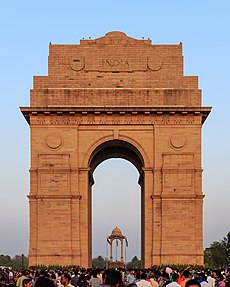| Lok Sabha Constituencies in New Delhi district, Delhi (MP Constituencies) | New Delhi |
| MLA Assembly Constituencies in New Delhi district, Delhi | Delhi Cantt Greater Kailash Kasturba Nagar Malviya Nagar New Delhi R K Puram Rajinder Nagar |
About the District :
New Delhi is the capital of India and one of Delhi city’s 11 districts. Although colloquially Delhi and New Delhi are used interchangeably to refer to the National Capital Territory of Delhi, these are two distinct entities, with New Delhi forming a small part of Delhi. The National Capital Region is a much larger entity comprising the entire National Capital Territory of Delhi along with adjoining districts. It is surrounded by Haryana on three sides and Uttar Pradesh on the east.
The foundation stone of the city was laid by George V, Emperor of India during the Delhi Durbar of 1911. It was designed by British architects, Sir Edwin Lutyens and Sir Herbert Baker. The new capital was inaugurated on 13 February 1931, by Viceroy and Governor-General of India Lord Irwin.
New Delhi has been selected as one of the hundred Indian cities to be developed as a smart city under Prime Minister of India Narendra Modi’s flagship Smart Cities Mission.
District at a Glance :
- District –
- Headquarters
- State
- Total –
- Rural –
- Urban –
- Population –
- Rural –
- Urban –
- Male –
- Female –
- Sex Ratio (Females per 1000 males) –
- Density (Total, Persons per sq km) –
- Assembly
- Loksabha
- Official Website –
Tourist Places :
Lotus Temple :

The Lotus Temple, located in Delhi, India, is a Bahá’í House of Worship that was dedicated in December 1986, having been completed for a total cost $10 million. It serves as the Mother Temple of the Indian subcontinent. Notable for its flowerlike shape, it has become a prominent attraction in the city. Like all Bahá’í Houses of Worship, the Lotus Temple is open to all, regardless of religion or any other qualification. The building is composed of 27 free-standing marble-clad “petals” arranged in clusters of three to form nine sides, with nine doors opening onto a central hall with height of slightly over 40 metres and a capacity of 2,500 people. The Lotus Temple has won numerous architectural awards and been featured in hundreds of newspaper and magazine articles. A 2001 CNN report referred to it as the most visited building in the world.
India Gate :

The India Gate, (originally called the All India War Memorial), is a war memorial located astride the Rajpath, on the eastern edge of the ‘ceremonial axis’ of New Delhi, India, formerly called Kingsway.
India Gate is a memorial to 82,000 soldiers of the Indian Army who died in the period 1914–21 in the First World War, in France, Flanders, Mesopotamia, Persia, East Africa, Gallipoli and elsewhere in the Near and the Far East, and the Third Anglo-Afghan War. 13,300 servicemen’s names, including some soldiers and officers from the United Kingdom, are inscribed on the gate.The India Gate, even though a war memorial, evokes the architectural style of the triumphal arch like the Arch of Constantine, outside the Colosseum in Rome, and is often compared to the Arc de Triomphe in Paris, and the Gateway of India in Mumbai. It was designed by Sir Edwin Lutyens.
In 1971, following the Bangladesh Liberation war, a small simple structure, consisting of a black marble plinth, with a reversed rifle, capped by a war helmet, bounded by four eternal flames, was built beneath the soaring Memorial Archway. This structure, called Amar Jawan Jyoti, or the Flame of the Immortal Soldier, since 1971 has served as India’s Tomb of the Unknown Soldier. India Gate is counted among the largest war memorials in India
Rashtrapati Bhavan :


Connaught Place is one of the largest financial, commercial and business centres in New Delhi, India. It is often abbreviated to CPand houses the headquarters of several noted Indian firms. The main commercial area of the new city, New Delhi, during the erstwhile British Raj, its environs occupy a place of pride in the city and are counted among the top heritage structures in New Delhi. It was developed as a showpiece of Lutyens’ Delhi with a prominent Central Business District.
Named after Prince Arthur, 1st Duke of Connaught and Strathearn, construction work began in 1929 and was completed in 1933. A metro railway station built under it is named Rajiv Chowk (after Rajiv Gandhi).
Latest Govt Job & Exam Updates: